Engineering Computational Methods
This report contains a statically analysis on the output result of 380 concrete samples to understand the relation between parameters and properties of concretes.
21 Pages5197 Words31 Views
Added on 2022-09-01
Engineering Computational Methods
This report contains a statically analysis on the output result of 380 concrete samples to understand the relation between parameters and properties of concretes.
Added on 2022-09-01
ShareRelated Documents
Engineering Computational Methods
Student Name:
Instructor Name:
Course Number:
30th December 2019
Student Name:
Instructor Name:
Course Number:
30th December 2019
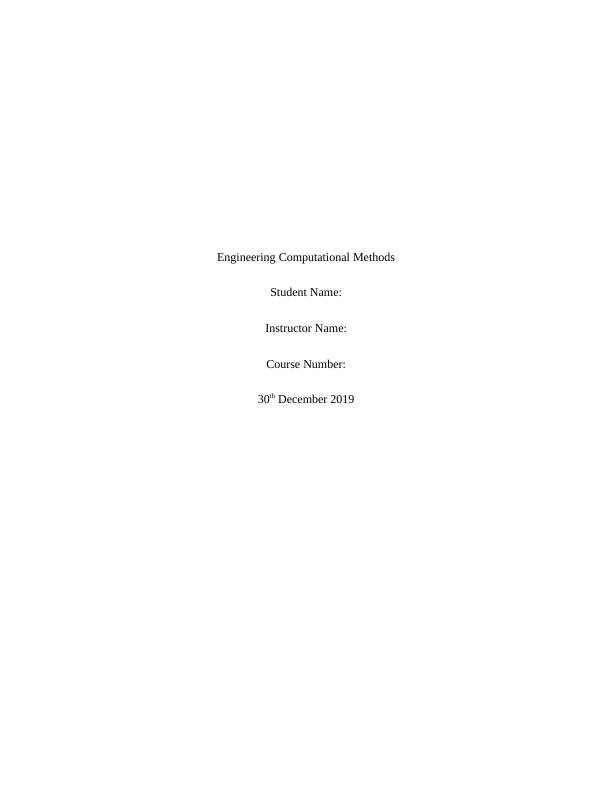
Introduction
There has been a rise in the consumption of concretes over the past years. The number of
concrete user is estimated to be more than 2.5 billion with the use of virgin materials being
considered to have negative effect on the environment (Aly, et al., 2012). The properties of a
good concrete are determined by factors such as compressive strength, bulk density, water
absorption and initial modulus of elasticity (Wongpa, et al., 2010). Optimizing the above-
mentioned properties is expected to result in high quality of concrete that are durable and of great
strength (Temuujin, et al., 2009).
Therefore, studying, identifying and analyzing parameters (Plasticizer, Curing Type,
coarse Aggregate, Fine, curing age and water/binder ratio) that influences these properties should
be taken in consideration. This study sought to identify the relationship between the different
parameters (Plasticizer, Curing Type, coarse Aggregate, Fine, curing age and water/binder ratio)
and the concrete properties (compressive strength, bulk density, water absorption and initial
modulus of elasticity).
The investigation focusses on how different parameters affects the different properties of
the concrete. Analysis is done using Statistical Package for Social Sciences (SPSS) where both
descriptive and inferential statistics is used to unravel the relationship that exists between the
different parameters and the concrete properties. Some of the inferential statistics applied in this
study include; Independent samples t-test and analysis of variance (one-way ANOVA).
There has been a rise in the consumption of concretes over the past years. The number of
concrete user is estimated to be more than 2.5 billion with the use of virgin materials being
considered to have negative effect on the environment (Aly, et al., 2012). The properties of a
good concrete are determined by factors such as compressive strength, bulk density, water
absorption and initial modulus of elasticity (Wongpa, et al., 2010). Optimizing the above-
mentioned properties is expected to result in high quality of concrete that are durable and of great
strength (Temuujin, et al., 2009).
Therefore, studying, identifying and analyzing parameters (Plasticizer, Curing Type,
coarse Aggregate, Fine, curing age and water/binder ratio) that influences these properties should
be taken in consideration. This study sought to identify the relationship between the different
parameters (Plasticizer, Curing Type, coarse Aggregate, Fine, curing age and water/binder ratio)
and the concrete properties (compressive strength, bulk density, water absorption and initial
modulus of elasticity).
The investigation focusses on how different parameters affects the different properties of
the concrete. Analysis is done using Statistical Package for Social Sciences (SPSS) where both
descriptive and inferential statistics is used to unravel the relationship that exists between the
different parameters and the concrete properties. Some of the inferential statistics applied in this
study include; Independent samples t-test and analysis of variance (one-way ANOVA).
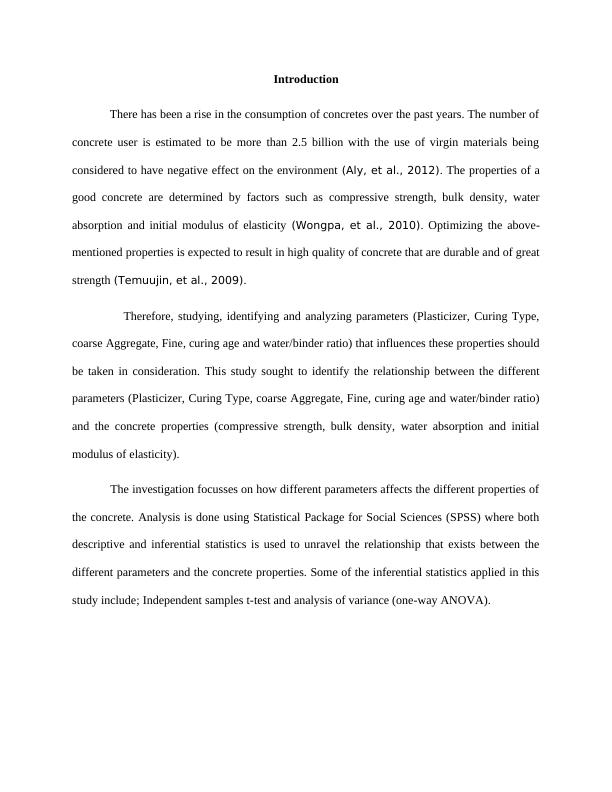
Literature Review
General
Concrete can be defined as a strong mass made from a solidifying medium, with the
ingredients being composed of sand, gravel, cement and water. The use of concrete as a building
material has be ongoing for close to 200 years. Its prosperity and ubiquity might be generally
ascribed to:
i. Toughness under threatening conditions
ii. Simplicity with which it very well may be thrown into an assortment of shapes and size
iii. Its easy availability and relative economy.
Concrete is strikingly solid in pressure however it is similarly powerless in strain.
Henceforth, the utilization of plain concrete as a basic material is constrained to circumstances
where noteworthy pliable burdens and strains do not develop (Mustafa, et al., 2011).
High Performance Concrete (HPC) is made with painstakingly chosen top-notch fixings
and improved blend structures. These are grouped, blended, set, compacted and restored to the
most elevated industry measures. Normally, such cements will have a high cement-water ratio of
0.55 to 0.80. Superplasticizers are generally used to make these solid. Nonetheless, quality isn't
generally the essential required property. For instance, an ordinary quality cement with
extremely high sturdiness and exceptionally low porousness is considered to have elite properties
(Xu, et al., 2010).
Raw Materials and Proportions of HPC
General
Concrete can be defined as a strong mass made from a solidifying medium, with the
ingredients being composed of sand, gravel, cement and water. The use of concrete as a building
material has be ongoing for close to 200 years. Its prosperity and ubiquity might be generally
ascribed to:
i. Toughness under threatening conditions
ii. Simplicity with which it very well may be thrown into an assortment of shapes and size
iii. Its easy availability and relative economy.
Concrete is strikingly solid in pressure however it is similarly powerless in strain.
Henceforth, the utilization of plain concrete as a basic material is constrained to circumstances
where noteworthy pliable burdens and strains do not develop (Mustafa, et al., 2011).
High Performance Concrete (HPC) is made with painstakingly chosen top-notch fixings
and improved blend structures. These are grouped, blended, set, compacted and restored to the
most elevated industry measures. Normally, such cements will have a high cement-water ratio of
0.55 to 0.80. Superplasticizers are generally used to make these solid. Nonetheless, quality isn't
generally the essential required property. For instance, an ordinary quality cement with
extremely high sturdiness and exceptionally low porousness is considered to have elite properties
(Xu, et al., 2010).
Raw Materials and Proportions of HPC
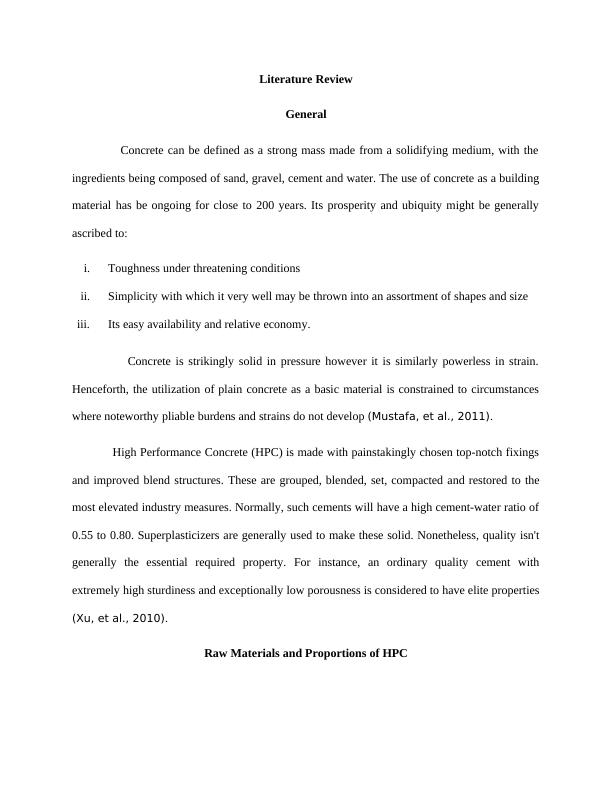
This section presents the different materials and their properties as well as the ratios for
obtaining high performance concrete.
Superplasticizer
According to ASTM494, Superplastisizers (SP) are alluded to "as high range water
diminishing admixture which for the most part scatters the water in solid lattice. Three
significant gatherings of Superplastisizers are as per the following: Sulphonated Melamine
Formaldehyde Condense (SMF), Sulphonated Nephthalene Formaldehyde Condense (SNF) and
Modified Lignosulphonates (MLS).The principle reason for utilizing Superplasticizing
admixtures is to lessen the water cement of a blend plan which upgrade solidness of cement. By
utilizing Superplastisizers, we can have flowable solid sort which can be put in hard and blocked
support region (Alnejaili, 2015). A few impacts of Superplastisizers on properties of cement are
as per the following:
Reduction in interfacial strain.
Multilayered adsorption of Organic particle.
Release of water caught among the concrete particles.
Retarding impact of concrete hydration.
Change in morphology of hydrated concrete
A study by (Kim, et al., 2010) considered the adsorption conduct of Sulfonated
melamine formaldehyde (SNF) in concrete for various introductory focus and revealed that its
fixation decline quickly in the initial five minutes after its expansion in to all concrete slurries. In
the vast majority of the cases its fixation arrives at a steady worth when adsorption time is more
prominent than 10 min and proposes a connection between the SNF adsorption conduct on
obtaining high performance concrete.
Superplasticizer
According to ASTM494, Superplastisizers (SP) are alluded to "as high range water
diminishing admixture which for the most part scatters the water in solid lattice. Three
significant gatherings of Superplastisizers are as per the following: Sulphonated Melamine
Formaldehyde Condense (SMF), Sulphonated Nephthalene Formaldehyde Condense (SNF) and
Modified Lignosulphonates (MLS).The principle reason for utilizing Superplasticizing
admixtures is to lessen the water cement of a blend plan which upgrade solidness of cement. By
utilizing Superplastisizers, we can have flowable solid sort which can be put in hard and blocked
support region (Alnejaili, 2015). A few impacts of Superplastisizers on properties of cement are
as per the following:
Reduction in interfacial strain.
Multilayered adsorption of Organic particle.
Release of water caught among the concrete particles.
Retarding impact of concrete hydration.
Change in morphology of hydrated concrete
A study by (Kim, et al., 2010) considered the adsorption conduct of Sulfonated
melamine formaldehyde (SNF) in concrete for various introductory focus and revealed that its
fixation decline quickly in the initial five minutes after its expansion in to all concrete slurries. In
the vast majority of the cases its fixation arrives at a steady worth when adsorption time is more
prominent than 10 min and proposes a connection between the SNF adsorption conduct on
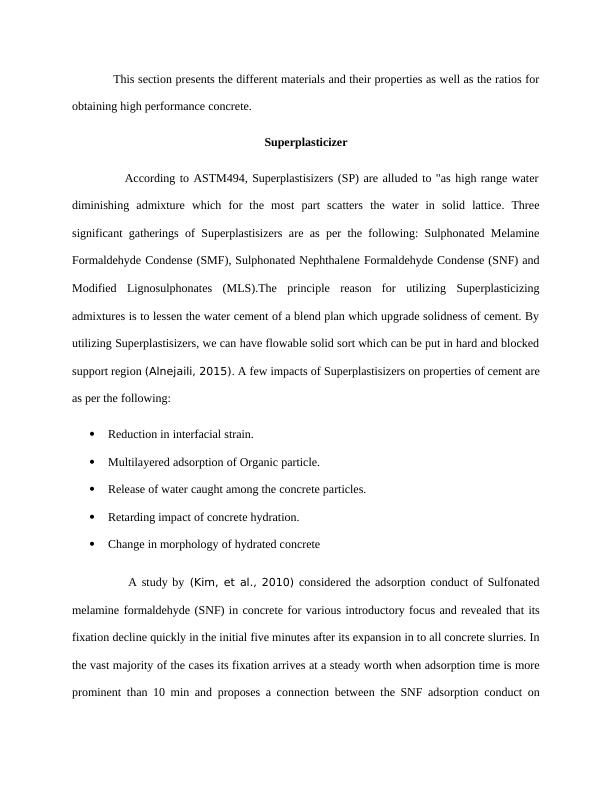
concrete particles and the usefulness of cement. (Lotfy, et al., 2015) led rheological tests on
concrete glue and these tests were utilized to choose the sort and dose of mineral admixtures that
improved solid usefulness. Six distinctive mineral admixtures are tried, just the ultrafine fly
debris gave the best outcomes by diminishing the thickness and yield pressure. These rheological
properties were not accomplished by expanding the water or the high range water decreasing
admixture measurements. The concrete glue rheological information was additionally contrasted
and little droop and bog cone. They presumed that tests are inconsistent for estimating the
functionality.
Curing Type
According to (Samir, et al., 1988),"Curing of cement is characterized as giving
sufficient dampness, temperature, and time to enable the solid to accomplish the ideal properties
for its expected use". At the point when cement is set and completed a legitimate relieving can
greatly affect its quality and strength. Inappropriate restoring of cement may prompt plastic (loss
of dampness when cement is crisp) and dry shrinkage (loss of dampness when solid set) splitting
(Safiuddin, et al., 2007). According to (Al Bakri, et al., 2011) and (Rovnaník, 2010),
legitimate relieving by keeping up proper temperature and dampness will decrease the volume of
pores in concrete by advancement of hydrate items which cause to decrease of porosity in
hydrated concrete glue. Also, keeping restoring concrete in wet condition cause to lessen greater
porosity with time subsequently expecting relieving period of 28days have more quality and
solidness than 7days of relieving. In these examples, two sorts of relieving (dry and wet) utilized
and their consequences for properties of solid will be broke down.
A study by (Farías, et al., 2017) researched the compressive quality of silica seethe
elite cement under various restoring strategies. The solid examples were held under five diverse
concrete glue and these tests were utilized to choose the sort and dose of mineral admixtures that
improved solid usefulness. Six distinctive mineral admixtures are tried, just the ultrafine fly
debris gave the best outcomes by diminishing the thickness and yield pressure. These rheological
properties were not accomplished by expanding the water or the high range water decreasing
admixture measurements. The concrete glue rheological information was additionally contrasted
and little droop and bog cone. They presumed that tests are inconsistent for estimating the
functionality.
Curing Type
According to (Samir, et al., 1988),"Curing of cement is characterized as giving
sufficient dampness, temperature, and time to enable the solid to accomplish the ideal properties
for its expected use". At the point when cement is set and completed a legitimate relieving can
greatly affect its quality and strength. Inappropriate restoring of cement may prompt plastic (loss
of dampness when cement is crisp) and dry shrinkage (loss of dampness when solid set) splitting
(Safiuddin, et al., 2007). According to (Al Bakri, et al., 2011) and (Rovnaník, 2010),
legitimate relieving by keeping up proper temperature and dampness will decrease the volume of
pores in concrete by advancement of hydrate items which cause to decrease of porosity in
hydrated concrete glue. Also, keeping restoring concrete in wet condition cause to lessen greater
porosity with time subsequently expecting relieving period of 28days have more quality and
solidness than 7days of relieving. In these examples, two sorts of relieving (dry and wet) utilized
and their consequences for properties of solid will be broke down.
A study by (Farías, et al., 2017) researched the compressive quality of silica seethe
elite cement under various restoring strategies. The solid examples were held under five diverse
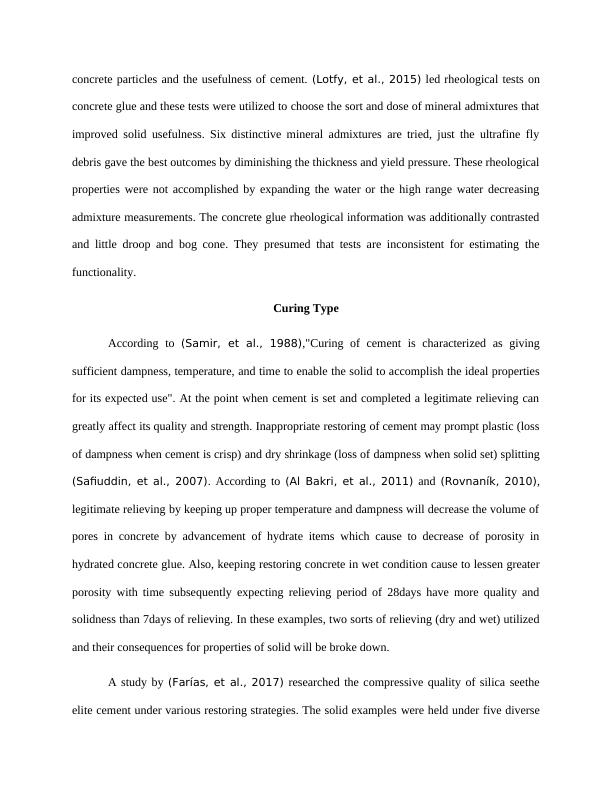
restoring conditions and in two unique situations for a time of nine months. The restoring
conditions utilized were water relieving (Control), no restoring, sprinkle restoring, plastic
relieving and burlap restoring. Every one of the last four conditions was presented to two unique
situations indoor condition and open air condition. The quality outcomes were resolved at 1, 3, 7,
14, 28 and 270 days. Finished up indoor examples were more delicate to relieving than those
restored open air. On account of the open air all these restoring techniques give comparable
outcomes because of the bone-dry nature of hot atmosphere.
Water/binder Ratio
The water/binder proportion has the most impact on properties of blend structure and
solidness, quality and life cycle of cement. According to (Tang, et al., 2011), "The proportion
of the measure of water to the measure of concrete utilized (both by weight) is known as the
water to solidify proportion (w/c). These two fixings are liable for restricting everything
together". The handy scope of water/cover proportion is between 0.3 to 0.8, the lower
water/fastener proportion the more quality and firm will be concrete and near 0.8 makes a wet
and genuinely powerless cement. In least difficult manner about water/concrete proportion, the
higher proportion cause to more prominent measure of water which lead to weaken the concrete
glue and impact the quality, porosity, shrinkage and shade of concrete (Tang, 2017).
Coarse Aggregate
A study was done by (Kim, et al., 2010) to experiment on the use of silica smolder in
concrete and assessed the impact of silica rage on the compressive quality and split rigidity and
modulus of versatility of low quality coarse aggregate cement. Concrete specimens were set up
with four kinds of low quality aggregates, to be specific calcareous, limestone, dolomite quartzite
conditions utilized were water relieving (Control), no restoring, sprinkle restoring, plastic
relieving and burlap restoring. Every one of the last four conditions was presented to two unique
situations indoor condition and open air condition. The quality outcomes were resolved at 1, 3, 7,
14, 28 and 270 days. Finished up indoor examples were more delicate to relieving than those
restored open air. On account of the open air all these restoring techniques give comparable
outcomes because of the bone-dry nature of hot atmosphere.
Water/binder Ratio
The water/binder proportion has the most impact on properties of blend structure and
solidness, quality and life cycle of cement. According to (Tang, et al., 2011), "The proportion
of the measure of water to the measure of concrete utilized (both by weight) is known as the
water to solidify proportion (w/c). These two fixings are liable for restricting everything
together". The handy scope of water/cover proportion is between 0.3 to 0.8, the lower
water/fastener proportion the more quality and firm will be concrete and near 0.8 makes a wet
and genuinely powerless cement. In least difficult manner about water/concrete proportion, the
higher proportion cause to more prominent measure of water which lead to weaken the concrete
glue and impact the quality, porosity, shrinkage and shade of concrete (Tang, 2017).
Coarse Aggregate
A study was done by (Kim, et al., 2010) to experiment on the use of silica smolder in
concrete and assessed the impact of silica rage on the compressive quality and split rigidity and
modulus of versatility of low quality coarse aggregate cement. Concrete specimens were set up
with four kinds of low quality aggregates, to be specific calcareous, limestone, dolomite quartzite
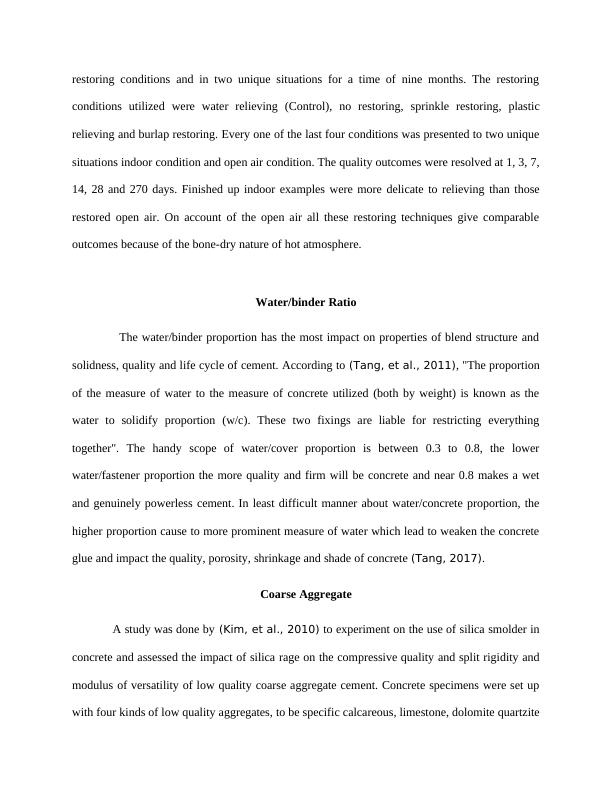
End of preview
Want to access all the pages? Upload your documents or become a member.
Related Documents
The number of people using generated energylg...
|27
|2781
|9
Assignment - 048353 Concrete Designlg...
|10
|2145
|42
Evolution of mechanical properties of concrete usinglg...
|7
|2065
|35
Composite Materials for Railway Trackslg...
|9
|1475
|136
Binders for Pavement Constructionlg...
|29
|5869
|120
Bendable Concrete 13 Running Head: Polyvinyl Alcohol in Creating a Bendable Concretelg...
|15
|3774
|405
